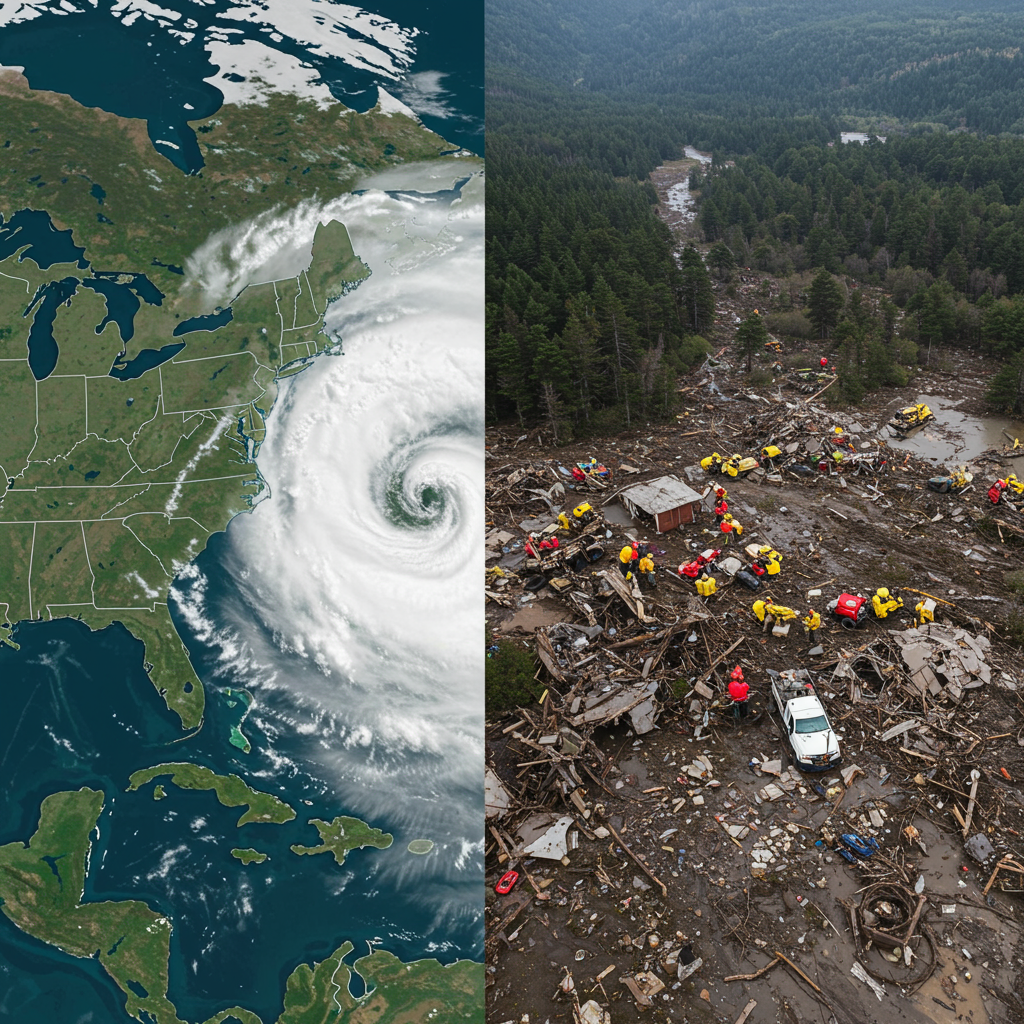The United States faced a rare, unprecedented dual assault from extreme weather events as a powerful Nor’easter battered the East Coast while remnants of Typhoon Halong ravaged western Alaska. This synchronized weather emergency brought widespread devastation, triggering states of emergency, prompting extensive rescue operations, and causing significant infrastructure damage from coastal flooding and hurricane-force winds. Millions were impacted, highlighting the urgent need for robust preparedness and resilient community responses across diverse geographic regions.
Dual Disasters: A Nation Under Siege by Extreme Weather
October 13, 2025, marked a day of intense weather chaos across the U.S. A slow-moving Nor’easter relentlessly churned up the eastern seaboard, delivering a punishing combination of coastal flooding, high winds, and torrential rain. Simultaneously, thousands of miles away, the remnants of Typhoon Halong unleashed a catastrophic storm surge and hurricane-force winds upon remote Alaskan villages. This unusual concurrence of two major weather systems on opposite sides of the continent stretched emergency resources and underscored the dynamic challenges of a changing climate.
East Coast Battles Powerful Nor’easter
The East Coast Nor’easter generated havoc from the Carolinas all the way to New England. Coastal communities bore the brunt of the storm, enduring unprecedented flooding and powerful onshore winds. This dramatic weather event prompted swift action from state and local authorities.
Coastal Flooding and High Winds Grip Region
States along the eastern seaboard experienced extensive disruption. In North Carolina’s Outer Banks, seawater surged over Highway 12 near Buxton, forcing road closures. South Carolina saw widespread coastal flooding in Georgetown County, where emergency crews rescued several stranded motorists. Downtown Charleston streets became impassable, while in Myrtle Beach, heavy rains overwhelmed the city’s stormwater system. Delaware activated its National Guard in response to rapidly rising floodwaters and harsh winds, underscoring the severity of the situation.
New Jersey and parts of New York City, including surrounding counties, were placed under a state of emergency. New York Governor Kathy Hochul urged residents to monitor forecasts and avoid unnecessary travel. AccuWeather hurricane expert Alex DaSilva noted that the storm could generate some of the highest tides the Northeast has seen in over a decade, with some beaches potentially submerging completely. Inland, parts of Long Island received up to 3 inches of rain, with wind gusts hitting 45-50 mph, escalating to 55-60 mph along the coast.
Tragedy and Travel Disruptions
The Nor’easter’s impact was tragically underscored in New York City. A 76-year-old woman died after a solar panel, dislodged by powerful winds, struck her. This devastating incident highlighted the unpredictable dangers posed by the storm’s intensity. Furthermore, the emergency declarations led to the cancellation of Manhattan’s annual Columbus Day parade, a significant cultural event. The storm also caused substantial travel disruptions, with hundreds of flights canceled and thousands delayed across U.S. airports, including major hubs like Boston Logan International and LaGuardia. Residents were advised to prioritize safety and heed local warnings to prevent further incidents.
Alaska Devastated by Typhoon Halong Remnants
Far to the west, Alaska grappled with the severe aftermath of Typhoon Halong. The typhoon remnants delivered hurricane-force winds and a powerful storm surge that literally ripped homes from their foundations and swept them out to sea. This catastrophic event unfolded in some of the most isolated communities in the United States.
Hurricane-Force Winds and Swept-Away Homes
Coastal hamlets like Kipnuk and Kwigillingok in western Alaska faced unimaginable destruction. Residents reported that entire homes were swept away by the raging waters, raising grave concerns for those potentially trapped inside. Jeremy Zidek, a spokesperson for the state division of homeland security and emergency management, confirmed these heartbreaking reports. The scale of the Alaska storm damage was immense, transforming familiar landscapes into debris fields.
Massive Rescue Operations Underway
In the immediate wake of the storm, extensive rescue operations commenced. More than 30 people were rescued across the affected region. In Kwigillingok, at least 18 individuals were brought to safety, though three remained unaccounted for. Sixteen people were rescued in Kipnuk, with reports of additional missing persons. Search efforts continued under challenging conditions. Local schools in Kipnuk and Kwigillingok quickly became shelters, housing nearly 600 and 300 residents, respectively.
Challenges of Remote Communities and Government Response
The extreme isolation of these Alaskan communities significantly complicated relief efforts. With few roads, residents primarily rely on boardwalks, boats, and snowmobiles for transportation. This unique infrastructure makes conventional rescue and aid delivery incredibly difficult. In response, Alaska Governor Mike Dunleavy extended a disaster declaration to communities within the Yupitt, Pribilof Island, and Lower Kuskokwim education districts. Governor Dunleavy assured affected residents that “Every effort will be made to help those hit by this storm. Help is on the way,” mobilizing state resources to assist with recovery.
Broader US Weather Front: Beyond the Coasts
The severe weather events were not confined to the East Coast and Alaska. Across the nation, other regions faced their own weather challenges, underscoring a period of widespread climatic instability. In the Phoenix area of Arizona, search and rescue teams were actively looking for a man whose truck was engulfed by floodwaters. Meanwhile, in Southern California, crews equipped with helicopters and bulldozers were pre-positioned near recent wildfire burn areas. This proactive measure aimed to mitigate potential debris flows and mudslides as a significant storm approached, threatening several inches of rain and up to three feet of mountain snow in the Sierra Nevada. This broader picture painted a stark image of a nation grappling with multiple, diverse, and extreme weather events simultaneously.
The Unseen Forces: Understanding the Storms
Understanding the meteorological dynamics behind these powerful weather systems is key to appreciating their impact. The Nor’easter and the typhoon remnants, while distinct, both unleashed immense destructive power.
A Nor’easter is a synoptic-scale extratropical cyclone in the western North Atlantic Ocean, primarily affecting the East Coast of North America. These storms are named for the strong northeasterly winds that blow in from the ocean ahead of the storm, pushing immense amounts of water ashore and causing significant storm surge. They are notorious for bringing heavy rain or snow, strong winds, and coastal flooding.
Typhoons, on the other hand, are mature tropical cyclones that develop in the western Pacific Ocean. While Typhoon Halong had weakened to remnants by the time it reached Alaska, it still carried formidable energy, manifesting as hurricane-force winds and devastating storm surges. The long-distance travel of such a powerful system, retaining enough energy to cause such destruction, is a testament to its original strength and the complex interplay of atmospheric currents. The simultaneous occurrence of these two geographically distinct but equally potent systems presents a complex challenge for weather forecasting and disaster preparedness.
Preparing for the Next Wave: Safety and Resilience
The widespread impact of these dual storms emphasizes the critical importance of preparedness and community resilience. For residents in coastal areas and remote communities, proactive measures can significantly mitigate risks. Staying informed through official weather advisories, creating emergency kits, and having evacuation plans are fundamental steps. Securing outdoor items, understanding your flood risk, and knowing local shelter locations are also vital. For those in isolated areas like rural Alaska, community-level planning for communication breakdowns and limited access to conventional aid becomes paramount. Learning from these events is crucial for enhancing future responses and protecting lives and property.
Frequently Asked Questions
What specific regions were most impacted by these extreme weather events?
The Nor’easter primarily impacted the U.S. East Coast, causing severe coastal flooding and high winds from the Carolinas to New England. Key affected states included North Carolina (Outer Banks), South Carolina (Georgetown, Charleston, Myrtle Beach), Delaware, New Jersey, and New York (including NYC, Long Island, and Westchester County). In Alaska, the remnants of Typhoon Halong devastated western coastal communities, particularly the isolated villages of Kipnuk and Kwigillingok, where homes were swept away.
How can residents access emergency assistance or shelter during severe storms like these?
Residents in affected areas should primarily monitor local government websites, social media channels, and emergency broadcast systems for up-to-date information on shelter locations and aid distribution. State-level emergency declarations, such as those issued in New Jersey and New York, often activate additional resources. Organizations like the National Guard (as seen in Delaware) and state divisions of homeland security and emergency management (like Alaska’s) coordinate relief efforts. Local police and fire departments are also key points of contact for immediate assistance and rescue operations.
What should homeowners in coastal and remote areas do to prepare for future severe weather?
Homeowners in vulnerable areas should develop comprehensive emergency plans, including designated meeting points and communication strategies. Crucially, prepare an emergency kit with at least three days’ worth of food, water, medications, and essential documents. For coastal residents, securing property, trimming trees, and considering flood insurance are vital. Those in remote Alaskan villages should establish community-level emergency networks, ensure access to alternative transportation (boats, snowmobiles), and reinforce homes against extreme winds and storm surges, while staying informed through satellite phones or other resilient communication methods.
Conclusion: A Call for Vigilance and Aid
The simultaneous onslaught of a powerful Nor’easter and the destructive remnants of a Pacific typhoon underscored the profound impact of extreme weather events on the United States. From the tragedy in New York City to the widespread devastation in remote Alaskan villages, these storms demanded immediate, coordinated responses. The extensive rescue efforts, widespread emergency declarations, and significant infrastructure damage highlight the urgent need for continued vigilance, robust preparedness, and compassionate aid for communities recovering from such intense climatic forces. As the cleanup begins, focusing on resilience and supporting those impacted will be paramount.




